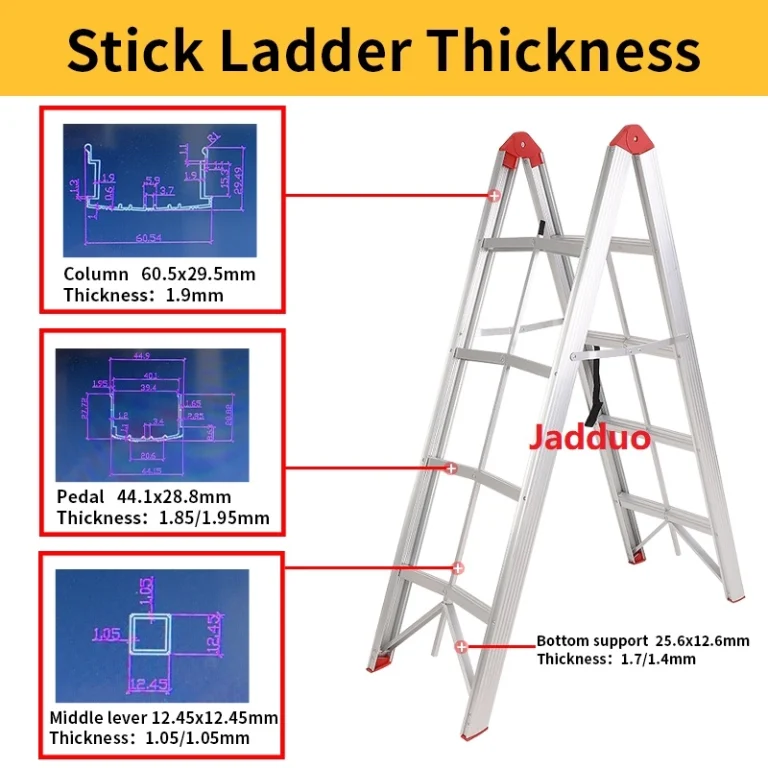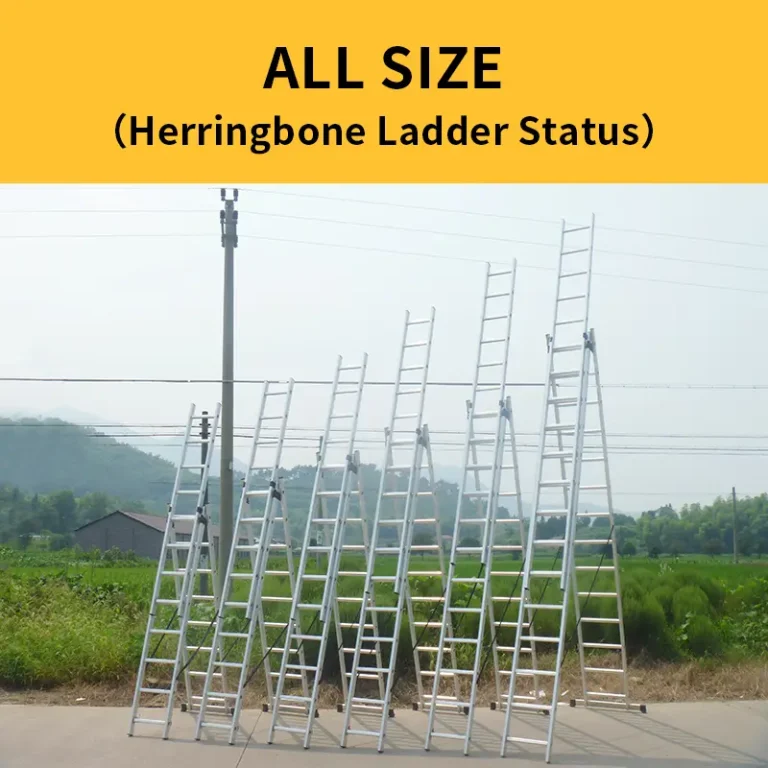This comprehensive guide examines critical safety measures for extendable ladders, including proper operation techniques, maximum load specifications, and necessary care procedures. It outlines important safety components like reinforced aluminum frames, sophisticated locking devices, and non-slip footings, presenting JADDUO ladders as exemplary products that meet EN131/ANSI certifications. The content underscores the value of pre-use inspections, correct installation methods, and consistent upkeep to maintain functionality and prevent workplace incidents during elevated tasks.

Why Is Ladder Safety So Crucial?
When working at altitudes, it’s crucial to follow safety rules diligently. Folding step stools offer convenience. Come with their own set of risks that must be handled with caution. Understanding these threats is key to avoiding accidents.
What Are the Common Risks of Using Telescopic Ladders?
Though handy to use; mishandling or constructed extendable ladders can lead to risky situations where falls are the most frequent occurrences often due to unstable positioning or worn out grip parts which may cause serious injuries when stability is lost on slippery steps or due to incorrect weight distribution; also using unreliable securing mechanisms could result in unexpected folding while in use.
Why Do Safety Standards in Ladder Design Matter?
Manufacturing guidelines ensure that ladders meet standards for longevity and user protection, with EN131 and ANSI certifications serving as quality benchmarks for professional tools. These rules mandate stress tests and anti-slip markings to minimize risks. Investing in gear guarantees adherence to these vital safety protocols.
How Stable Are Telescopic Ladders?
Structural soundness is paramount when selecting an extendable ladder. Construction quality directly affects performance under stress.
How Can You Evaluate the Build Quality of Telescopic Ladders?
What Should You Know About Material Strength and Durability?
A ladder’s substance composition determines its robustness and service life. Aluminum alloys have become the preferred material, offering both lightness and resilience. These metal blends resist oxidation effectively, even in humid conditions, ensuring extended functionality.

Why Does Reinforced Aluminum Alloy Matter?
Modern designs incorporating fortified aluminum mixtures enhance both stability and lifespan. These innovations distribute weight evenly across the framework, reducing pressure points that could cause structural failures.
For instance, the JADDUO Extendable Ladder utilizes reinforced aluminum with advanced strengthening techniques, delivering exceptional reliability for diverse applications.
How Do Locking Mechanisms Prevent Accidents?
Securing components is vital for maintaining ladder stability during operation. Properly engineered systems minimize collapse risks.
Which Types of Locking Systems Are Used in Telescopic Ladders?
Single-Locking vs. Double-Locking Mechanisms
Single lock systems offer security but may not have a backup plan in case of malfunction situations; on the other hand, double lock mechanisms enhance safety by individually securing each step for added protection.
What Makes Multi-Lock Technology Superior?
Cutting-edge multi-lock systems stand as a breakthrough in ladder safety technology. They guarantee that each segment locks firmly in place prior to utilization, preventing any collapsing while bearing weight. The cutting-edge Multi Lock Technology, from JADDUO, showcases this ingenuity by blending craftsmanship and intuitive functionality to bolster safety measures.
Weight Capacity and Load-Bearing Limits
How to Determine the Right Weight Capacity for Your Needs
Choosing a ladder with suitable load tolerance is essential for safe operation. Material quality, frame design, and production standards all influence performance. Premium aluminum alloys are particularly valued for their favorable strength-to-weight ratio, durability, and corrosion resistance. Residential projects typically require 100-150kg capacity, while industrial applications may demand several hundred kilograms for equipment transport.
Overloading Risks and Their Consequences
Overburdening can cause structural failure. Exceeding weight limits creates concentrated stress that may lead to sudden breakdowns. This endangers users and reduces product lifespan. Always verify total weight (user plus tools) remains within specifications.
JADDUO’s High Load-Bearing Models for Heavy-Duty Tasks
For demanding tasks requiring exceptional load-bearing capacity, consider JADDUO’s reinforced aluminum models. These incorporate advanced engineering to distribute weight evenly, ensuring optimal stability with heavy loads.
Proper Usage and Maintenance Guidelines
Best Practices for Safe Operation of Telescopic Ladders
To ensure the use of a telescopic ladder is more than just setting it up correctly, before beginning to use the ladder, check for any cracks or problems first, and position it on a surface at a 75-degree angle, for proper balance, and be careful not to overextend or climb above the recommended height.
Setting Up on Different Surfaces Safely
When preparing to use a telescopic ladder on surfaces like uneven ground or slippery areas, ensure stability by utilizing stabilizers or leveling tools on irregular surfaces and improve traction with anti-slip mats or bases for slippery spots.
JADDUO’s Anti-Slip Base Features for Maximum Stability
The ladder design is improved for safety by adding slip features to it. Equipped with textured rubber feet that offer grip on different surfaces, the JADDUO Telescopic Ladder decreases the chances of slipping while in use.
Maintenance Tips to Prolong Ladder Lifespan
Make sure you regularly maintain your telescopic ladder to ensure it lasts long and remains reliable over time. Remember to clean the steps and connections to get rid of any dirt that could impact its performance and apply lubricant to the moving parts occasionally to prevent damage. Don’t overlook checking the locking mechanisms to ensure they are working correctly.
Certifications and Compliance with Industry Standards
How JADDUO Ensures Compliance with Global Safety Standards
Quality certifications validate product reliability. EN131 and ANSI-compliant ladders undergo exhaustive testing for durability, capacity, and safety features. JADDUO products meet these international requirements, ensuring user confidence through strict adherence to safety protocols.
FAQs
Q1. What pre-use inspections are necessary?
A: Examine for damage, verify lock functionality, and confirm stable positioning. Avoid using ladders in a hurry or choosing uneven or slippery surfaces to place them on. Be careful and check the ground beforehand before placing a ladder to ensure its stability. Use the ladder according to the included instructions in the box. When stepping on the ladder, remember not to jump or overextend the ladder, as this could cause it to become unbalanced, resulting in a potentially serious injury.
Q2. Why choose aluminum for extendable ladders?
A: Aluminum provides an ideal balance of lightness, strength, and corrosion resistance for indoor/outdoor use. Aluminum ladders are durable and resistant to rust, corrosion and weather damage, so they can be used both indoors and outdoors. JADDUO uses 6063-T5 high-grade aerospace engineering grade aluminum.
Q3. What maintenance ensures longevity?
A: Regular cleaning, lubrication, lock inspections, and proper dry storage.









